New Specialized Tarmac SL8: lighter and more aerodynamic than ever before
The Specialized Tarmac SL8 has done it again. The eighth generation of its Tarmac, its flagship bike for the last 20 years, has managed to improve once again what seemed like it couldn't be taken any further. A new Tarmac SL8 that is now much lighter than its predecessor while maintaining excellent aerodynamics and that characteristic Tarmac handling that has made it, season after season, one of the biggest dreams of all riders.

Specialized Tarmac SL8: lightness, aerodynamics and ride quality
There is no doubt that the level that Specialized has reached as a reference brand in the cycling world has achieved such heights that every time the brand prepares a launch everyone talks about it and tries to find out what it is as soon as possible. It happened a few months ago when the brand launched its renewed Epic mountain bike and now, with the renewal of its Tarmac, the expectation has reached incredible proportions, especially when just a few days ago several images of the Soudal-QuickStep riders on these new bikes were spotted.
Looking back
To understand what the launch of this SL8 means for Specialized and to put it in context, we have to go back to the early 1980s, when Specialized launched its first bikes on the market, which, despite what many people think since they always talk about the famous Stumpjumper, were road bikes, with its now legendary Allez.
However, it was in mountain biking that Specialized made it big, so we have to go all the way back to the early years of the 21st century to find the moment when Specialized began to make a firm commitment to thin wheels.
RECOMENDADO

What is heart rate variability and how does it affect the cyclist?

Change wheels if you want to transform your bike's behavior

What bike size do you need? Here's how to find out

How does age affect performance and recovery?
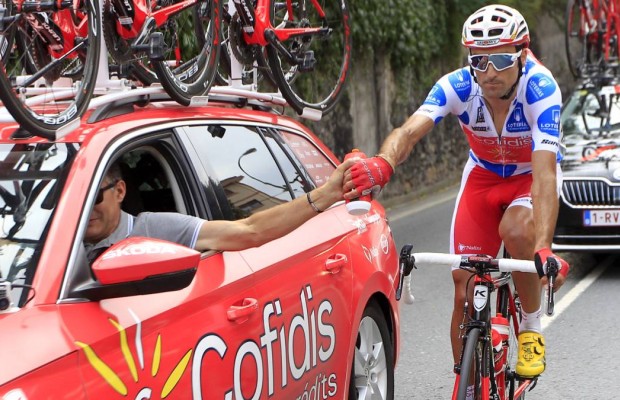
How long cyclists can be pushed when handed a sticky bottle?

10 tips for safer and faster downhills on road bikes

In 2003 the first bike with the name Tarmac was born, the E5, a strange combination, common in the bikes of that time, although interpreted in a particular way by the brand, combining a carbon upper part with an aluminum lower part, but which, however, allowed them to begin to learn about that new material, at that time, which was carbon fiber.
It was not until 2007 that the Tarmac SL1 saw the light of day and the start of the collaboration, which still continues today, with QuickStep, in particular with Tom Boonen, one of those cyclists who is extremely detailed with the material and capable of perceiving every change in the behavior of the bike and transmitting his needs to the engineers. This is the kind of rider with whom every brand wants to develop a new bike.
The Belgian told the brand about the imbalance of this first Tarmac between the stiffness of the front and rear, which was corrected in the SL2, launched the following year and which had a rolling quality and levels of stiffness and weight that would not be out of place among today's bicycles. At that time the brand encountered another problem, the different behavior that existed between large and small size bikes.

On the other hand, in 2015 aerodynamics on road bikes was starting to become a necessity on racing bikes. Specialized partnered with McLaren, from whom they learned this science. As a result of this partnership, the spectacular Venge ViAS was born, designed in Specialized's own wind tunnel built at Morgan Hill, the first one specifically created for the speeds at which the bikes move.
So we arrived in 2018 where the range was divided between the lightweight Tarmac and the third generation of the super-erodynamic Venge. Why not combine the features of both bikes in a single model? Specialized is not afraid of challenges so they went for it, and in the midst of the pandemic, the current Tarmac SL7 was born, a simply spectacular machine.
What's new in the Tarmc SL8
Renew or die is the mantra. We had to think about where the Tarmac SL7 could be improved. In recent years we have seen how the incorporation of aerodynamic features such as profiled tubes or systems to guide the cabling inside the head tube has meant, with the addition of disc brakes, a significant increase in weight on the bikes, moving today the machines used by professionals around 7 kg, far from the 6.8 that the UCI sets as a limit and that in the past forced mechanics to weight the bikes to reach that figure.

On the other hand, making a bike as light as possible can result in a reduction of riding qualities such as ease of acceleration or cornering control. In addition, comfort is also an essential quality when it comes to spending long hours on the bike.
In other words, improving one quality means having to improve the rest of the parameters in order to maintain the perfect balance already achieved by the Tarmac SL8. Well, Specialized has done it again and the numbers speak for themselves: 16 seconds faster in 40 kilometers, 15% lighter than its predecessor or 6% more flex capacity in the saddle area that, together with a slight increase in stiffness, improve the bike's stiffness/lightness ratio by 33%.
Taking away what's excess
When it comes to reducing the weight of the bike, it must be taken into account that traditionally it has been an opposing aspect, i.e. more aerodynamic bikes had to have wider and deeper tubes, which means more material and, therefore, more weight.
To address both issues Specialized opted for a Solomonic solution: improve aerodynamics only in the parts where it is most relevant and in those whose influence against the wind is minimal forget about them and reduce them to the minimum expression in order to subtract grams to the frame of the new Tarmac SL8. To do this, they took an SL7 and put it in their wind tunnel. They sprayed the air with paint to see which parts of the bike would stick, i.e. where the wind would hit the most.

The image is eloquent and quite expected on the other hand. The places where the incidence of wind has the greatest influence are those that first come into contact with it, i.e. head tube, handlebars. Also the leading edge of the seatpost and the seat tube itself were important. However, at the front, where the incoming airflow is laminar, any aerodynamic improvement is greater than at the rear where the so-called dirty air circulates, full of turbulence after passing through other parts of the bike and interacting with the wheels and the rider's legs.
Focused on improving the entire front end, the Specialized Tarmac SL8 features a more prominent forward head tube and narrower front end, a fork head integration design reminiscent of the latest generation Venge and the addition of the Roval Rapide integrated handlebar/stem set that the brand introduced a few months ago and that already at the end of last year made us speculate that the SL8 was close to seeing the light of day.
It is worth mentioning that, contrary to the current trend of optimizing aerodynamics with tyres with increasingly generous balloons, the Tarmac SL8 will be fitted with 700x26c tyres as standard, although it has wheel arches that allow up to 32 mm to be fitted, with a view to racing the classics which, except in the Roubaix where the eponymous bike is used, in the rest of the races the professionals only use Tarmac.

This left Specialized engineers a lot of room to remove material at the rear, something that is evident in a seat tube that has the same section that had the seatpost of the SL7, being therefore the seatpost of this new Tarmac SL8 the minimum expression, the minimum to fit inside the Di2 battery if we opt for a Shimano mount as this has been the chosen location for it. The chainstays and top tube are also visibly thinner.
This, together with an intense simulation work with their own finite element modeling programs with which they simulate the different loads, stresses, stiffness, bending... and obtain the optimal arrangement of the up to 500 carbon sheets that make up this SL8; and fluid dynamics with which the aerodynamic influence of each element of the bike is calculated. Specialized has carried out no less than 54 iterations, i.e. 54 virtual prototypes, in order to get the most out of its Fact 12r carbon.
The S-Works Tarmac SL8 frame weighs 685 grams in size 56, 115 less than the S-Works Tarmac SL7 frame and 275 less than the last S-Works Venge manufactured by Specialized, with the addition that this Tarmac SL8 is even more aerodynamic than the last one, thanks in part to the relaxation of the UCI rules that the brand has also taken advantage of in this new bike. What's more, the second step up in the range, the SL8 frame made from Fact 10r carbon used in the Pro and Expert setups is also lighter than the S-Works SL7 was. A lightweighting job in which the development of the Aethos has also played an important role, with which they have learned several useful recipes for how to eliminate material without affecting stiffness.

Of course, in this new bike Specialized continues to use its Rider First technology, which involves creating a different frame for each of the sizes so that, although the external design is the same, its structure is formed by a different number, shape and arrangement of the carbon sheets, which also involves significant engineering work.
It is worth mentioning that Specialized has not changed the geometry and sizing of the SL7 in order to maintain a performance on the road that they consider unbeatable. These dimensions have already benefited from the knowledge acquired by the brand from the huge amount of information in the Retül biomechanical system database.
A bike that is available right now, in fact, riders like Remco Evenepoel today or Demi Vollering in the women's race of the Road World Championships in Glasgow, which will take place next Sunday, will use a bike in which they have actively participated in its development, communicating to the engineers of the brand their feelings and requests to make the perfect bike.
Specialized Tarmac SL8: models and prices
S-Works Tarmac SL8 – Shimano Dura-Ace Di2

- Price: 14,000 €
- Weight: 6.71 kg
- Frame: Fact 12r
- Groupset: Shimano Dura-Ace Di2. 4iiii Precision Pro Dual 52/36 cranks with power meter. Casette 11-30
- Handlebar/Stem: Roval Rapide Cockpit
- Wheels: Roval Rapide CLX II
- Tyres: S-Works Turbo Rapidair 2BR 700x26c
- Seatpost: S-Works Tarmac SL8 Fact. 15 mm offset
- Saddle: Body Geometry S-Works Power carbon rails
S-Works Tarmac SL8 – SRAM Red AXS
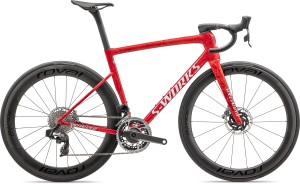
- Price: 14,000 €
- Weight: 6.86 kg
- Frame: Fact 12r
- Groupset: SRAM Red AXS. Cranks with power meter 48/35. Casette 10-33
- Handlebar/Stem: Roval Rapide Cockpit
- Wheels: Roval Rapide CLX II
- Tyres: S-Works Turbo Rapidair 2BR 700x26c
- Seatpost: S-Works Tarmac SL8 Fact. 15 mm offset
- Saddle: Body Geometry S-Works Power carbon rails
Tarmac SL8 Pro – Shimano Ultegra Di2
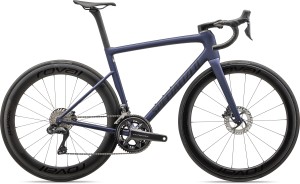
- Price: 9,000 €
- Weight: 7.2 kg
- Frame: Fact 10r
- Groupset: Shimano Ultegra Di2. 4iiii 52/36 Cranks with power meter. Casette 11-30
- Handlebar: Roval Rapide Carbon
- Stem: Tarmac integrada
- Wheels: Roval Rapide CL II
- Tyres: S-Works Turbo Rapidair 2BR 700x26c
- Seatpost: S-Works Tarmac SL8 Fact. 15 mm offset
- Saddle: Body Geometry Power Pro titanium rails
Tarmac SL8 Pro – SRAM Force AXS
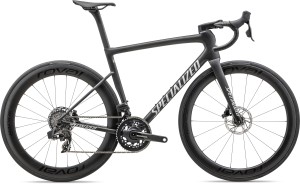
- Price: 9,000 €
- Weight: 7.44 kg
- Frame: Fact 10r
- Groupset: SRAM Force AXS. Cranks with power meter 48/35. Casette 10-33
- Handlebar: Roval Rapide Carbon
- Stem: Tarmac integrada
- Wheels: Roval Rapide CL II
- Tyres: S-Works Turbo Rapidair 2BR 700x26c
- Seatpost: S-Works Tarmac SL8 Fact. 15 mm offset
- Saddle: Body Geometry Power Pro titanium rails
Tarmac SL8 Expert – SRAM Rival AXS
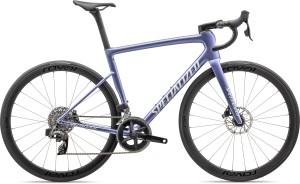
- Price: 6,500 €
- Weight: 7.77 kg
- Frame: Fact 10r
- Groupset: SRAM Rival AXS. Cranks with power meter 48/35. Casette 10-36
- Handlebar: Specialized Expert
- Stem: Tarmac integrada
- Wheels: Roval C38
- Tyres: S-Works Turbo Rapidair 2BR 700x26c
- Seatpost: S-Works Tarmac SL8 Fact. 15 mm offset
- Saddle: Body Geometry Power Expert
S-Works Tarmac SL8 Frame

- Price: 5,500 €
- Weight: 685 g
- Material: Fact 12r Carbon
- Includes: fork, seatpost, saddle clamp
Tarmac SL8 Frame
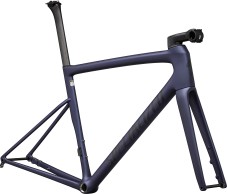
- Price: 4,000 €
- Weight: 780 g
- Material: Fact 10r Carbon
- Includes: fork, seatpost, saddle clamp
Further information is available on the official Specialized website.